Located in the South Pacific, spread across several small islands, sits on of the least visited national parks in the USA, the National Park of American Samoa.
Go snorkeling, hike to the tallest peaks for stunning views across the islands, visit remote beaches, and learn about Samoan culture…these all top the list of things to do in the National Park of American Samoa.
In this guide, we share with you the best things to do in this national park, how to plan your time, plus lots of tips that we learned on our visit here.
Interesting Facts about the National Park of American Samoa
The National Park of American Samoa is the only US national park that is located south of the equator.

This small national park is spread out across three islands on American Samoa: Tutuila, Ofu, and Ta’u.
Because of this park’s remote location, it is one of the least visited national parks in the USA. In 2023, it only had 12,000 visitors all year, placing it #2 on the least visited US national parks for that year. To put this number into perspective, the Grand Canyon averaged 13,000 visitors per day in 2023.
The National Park of the American Samoa preserves a lot of wildlife you won’t see in other US national parks. Flying foxes, also known as fruit bats, can be found in the rainforests and are essential members of the ecosystem as they pollinate the plants. Coral reefs are home to 800 native fish and 200 coral species in the park. Sea turtles are also frequently spotted in the national park and on the islands of American Samoa.
The national park also helps to preserve the Samoan culture. There are a lot of local customs you will need to know about before your visit, which we cover later in this guide.
On November 1, 1988, the National Park of American Samoa officially became a US national park.
Please practice the seven principles of Leave No Trace: plan ahead, stay on the trail, pack out what you bring to the hiking trail, leave areas as you found them, minimize campfire impacts, be considerate of other hikers, and do not approach or feed wildlife.

National Park of American Samoa Sign
Overview of the National Park of American Samoa
The National Park of the American Samoa is spread across three islands: Tutuila, Ofu, and Ta’u.
Tutuila is the largest island in American Samoa. This is the location of the Pago Pago International Airport, so this will be your arrival point into the country. The national park only makes up a small portion of this island but there are a lot of wonderful places to visit, which we cover in our Guide to American Samoa.
The Manu’a Islands are more remote. To get here, you will take a flight from Tutuila. This is the location of Ta’u and Ofu islands. Ofu is famous for its remote beach, which some people say is the most beautiful in the world.

Map of the Samoan islands and the location of Tutuila island and the Manu’a Islands in American Samoa.
Best Things to Do in the National Park of American Samoa
In no particular order, here are the best things to do in the National Park of American Samoa. You can see the location of all of these on the map at the end of this list.
1. Learn More about the Park at the Visitor Center
Location: Tutuila Island
Located in Pago Pago, the Visitor Center is a wealth of information about the park. This is a good place to start your visit to the national park and to pick up a park map and ask any questions you may have about the park.

Visitor Center
To give you an idea of how few people visit this national park, on some days the visitor center gets zero visitors (at least, that was the case during our visit in May 2023). There’s a good chance you could be the only ones here, like we were.
Get updated visitor center hours on the official website.
2. Viewpoint of Pola Island
Location: Tutuila Island
This popular viewpoint of Pola Island is relatively easy to get to. It is located on Route 006 next to the trailhead for the Lower Sauma Ridge Trail. From the small car park, walk to the informational signs for this view.

Pola Island Viewpoint

Pola Island Viewpoint | Things to Do in the National Park of American Samoa
3. Lower Sauma Ridge Trail
Location: Tutuila Island
Distance: 0.4 miles round trip | Difficulty: Moderate | Elevation Gain: 175 feet | Time: 30 to 45 minutes
This very short hike heads downhill to the tip of a peninsula for panoramic views of Pola Island and the Vai’ava Strait National Natural Landmark.
Park in the same car park as for the Pola Island viewpoint. To the right of the fale is the trailhead, which is marked by a small sign. The trail heads downhill through a forest, and it is a mix of steps and a pathway that can be steep at times.
The trail ends at the point of the peninsula. From here, you can see Pola Island in one direction and more of the northern coast of Tutuila island in the opposite direction.
We did not think this trail was worth the effort. The view from this hike is only slightly better than it is from the car park. But on a sunnier day than what we had, if you are into photography, this short hike could be worth it.
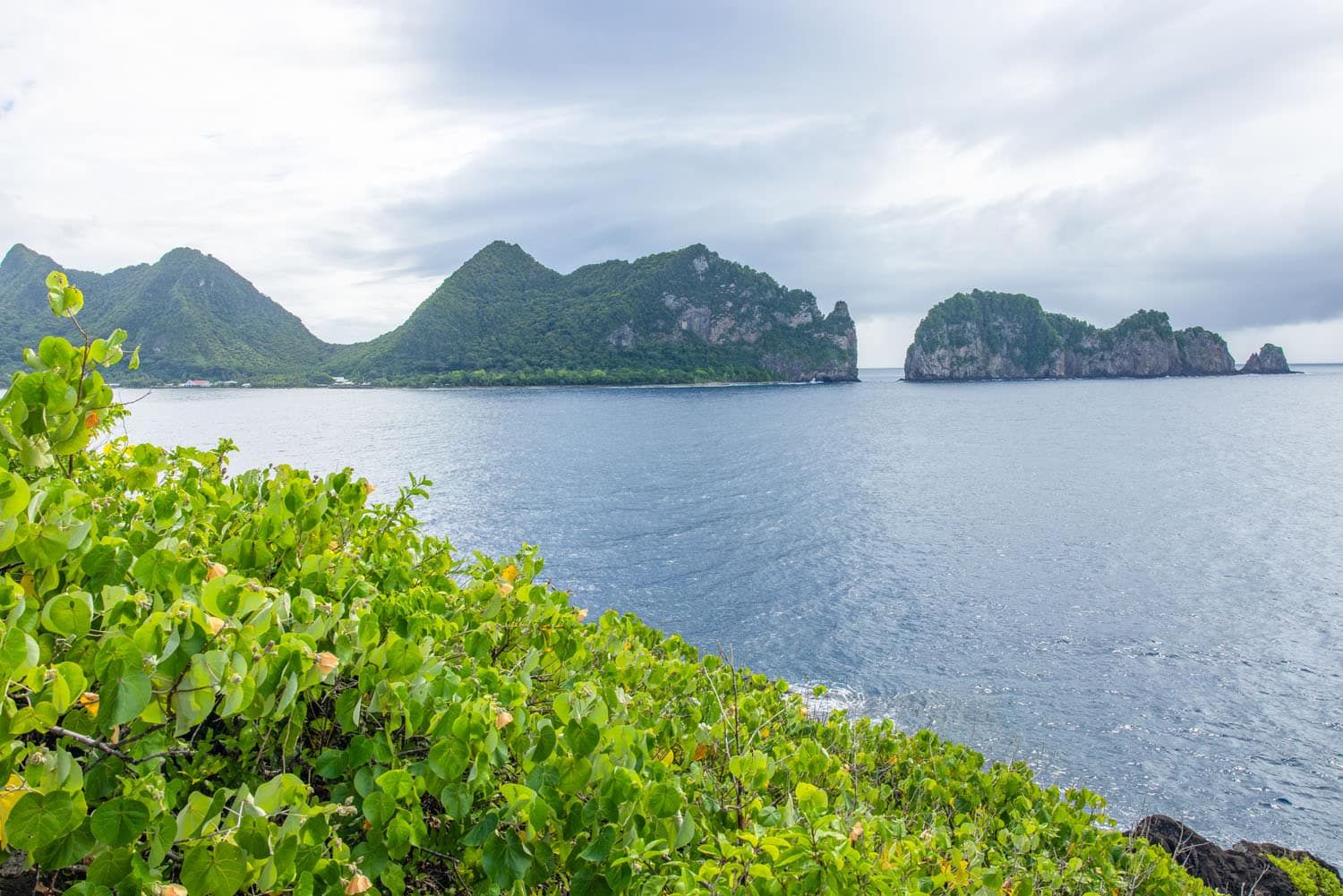
View from the Lower Sauma Ridge Trail

Steps on the Lower Sauma Ridge Trail
4. Pola Island Trail
Location: Tutuila Island
Distance: 0.1 miles round trip | Difficulty: Easy | Elevation Gain: Flat | Time: 15 minutes
With such a short distance, it’s hard to classify this one as a hike, but that’s how it’s listed in the national park brochure. The drive to get here feels more like an adventure than the actual hike.
In recent years, the parking area was moved closer to Pola Beach, because of unfriendly dogs in Vatia.
To get to the parking area, drive Route 006 through Vatia. You will pass the Mauga o Alava Elementary School on your left and then the road changes to a gravel road. It is one lane at this point and Vatia Bay will be to your right.
Continue down this gravel road. You will pass a small blue house and a national park sign. Keep going past this until the road ends. The parking area is located in a forest and is marked by several informational signs. Park here and it takes less than a minute to walk the short trail to the beach.

Pola Island Trail Parking Area

Pola Island Trail | Things to Do in the National Park of American Samoa

You can explore the very rocky beach but the water currents can be very strong so don’t go into the water.
We thought this was a beautiful spot and well worth the drive to get here.
5. Tuafanua Trail
Location: Tutuila Island
Distance: 2.2 miles round trip | Difficulty: Moderate | Elevation Gain: 400 feet | Time: 1 to 2 hours
This trail starts next to the Mauga o Alava Elementary School in Vatia and you will pass it on the drive out to the Pola Island Trail.
This short, 2.3 mile round trip hike will take you up and over a nearby ridge down to a beach for views of the coast and surrounding cliffs. The trail features some steep sections of climbing along terrain that can be slippery, so make sure to pack shoes with some level of traction.

Tuafanua Trail parking. The trailhead is located to the left of the building in this photo.
From the trailhead, it doesn’t take long to enter the treeline, and the trail will steadily rise to the top of the ridge, taking roughly 15 minutes. You’ll pass over plenty of roots, rocks, and decaying palm leaves. If it recently rained, like it had for us, this trail can be very slippery so do your best to watch your footing.
Upon reaching the top of the ridge, continue forwards to descend towards the beach. The descent here is much steeper. You’ll follow a trail of makeshift steps where it can be difficult at times to keep your footing. There are ropes that run alongside the path that you can use as support, which are incredibly helpful as some of the stairs are loosely attached to the ground.

Steps on the Tuafanua Trail
As you make your final few steps onto the beach, the trail will lead through some very thick foliage. Once standing on the beach it can be tricky to find your way back onto the trail. Look for a landmark that marks your trail as you step onto the beach as a method of making your way back home.
The beach fully consists of rock and is very similar to the beach on the Pola Island hike. If you’re looking to see beaches with a limited amount of time, I’d recommend the Pola Island Trail instead of this hike. If you want a beach that’s a bit more secluded and a challenge to reach, then this one is for you.

View of Pola Island and the Vai’ava Strait from the end of the Tuafana Trail
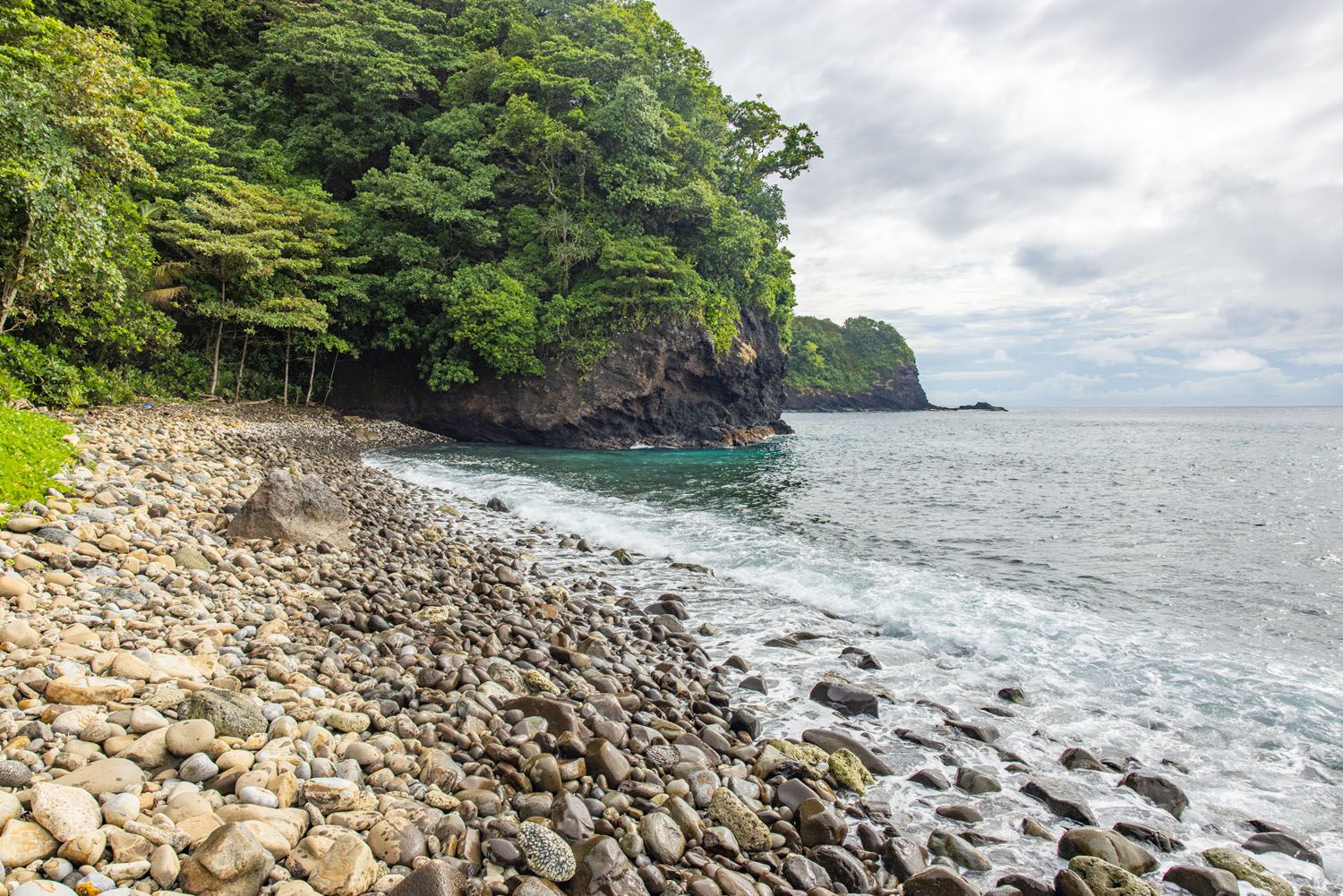
Looking the other direction from the end of the trail.

Climbing the steps on the return hike.
6. The Mount ‘Alava Trail
Location: Tutuila Island
Distance: 7 miles out-and-back | Difficulty: Strenuous | Elevation Gain: 1,500 feet | Time: 3 to 5 hours
The main reason for hiking the Mount ‘Alava Trail is for panoramic views over Tutuila Island and Pago Pago.
This is the longest trail on the list and for most of it, you are walking through a rainforest, so you don’t have much of a view. There are only a few spots where there is a clearing and you can look out over the island.
The Mount ‘Alava Trail starts at the Fagasa Pass and follows the ridgeline until you get to Mount ‘Alava. Enjoy the view over the Pago Pago Harbor and then retrace your steps back to the parking lot.
If it is cloudy, skip this hike. On rainy days, Mount ‘Alava can be clouded in so you won’t see anything once you get to the viewpoint.

The view of Pago Pago Harbor from the Mount ‘Alava Trail
7. The Mount ‘Alava Trail & Mount ‘Alava Adventure Trail
Location: Tutuila Island
Distance: 5.3 miles point-to-point | Difficulty: Strenuous | Total Ascent: 1,500 feet | Time: 3.5 to 5.5 hours
This hike is done point-to-point and includes both the Mount ‘Alava Trail, mentioned above, plus the Adventure Trail, which connects Mount ‘Alava with the small town of Vatia.
This is shorter than hiking the Mount ‘Alava Trail out and back but it is a lot more challenging.
We did this hike starting at the Fagasa Pass trailhead, first hiking the Mount ‘Alava Trail and ending with the adventure trail. I was the shuttle and Tim and Tyler did the hike.
The first part of the hike is relatively easy, since it is a walk through the forest with some ups and downs. The day before and the morning we did this hike, the island got a lot of rain, which created massively muddy, slippery conditions.
From Mount ‘Alava, it is very steep downhill walk/slide (if it has been raining) to Vatia. There are a total of 56 ladders and 783 steps. For Tim and Tyler, that was the easy part. There is also a fair amount of hiking trail in the woods. This was super slick and both Tyler and Tim fell multiple times. It was also incredibly overgrown and looked as if they were the first hikers since the start of COVID three years ago.
This really is an adventure. If you like the idea of lots of steps, mud, and going off the beaten path, put this hike on your list. But if you just want a nice view over Pago Pago, then stick just with the Mount ‘Alava Trail.
Learn more, and see a lot more photos, in our Guide to the Mount ‘Alava Trail.

The view from the Mount ‘Alava Adventure Trail


8. See a Flying Fox
Location: Tutuila Island
Flying foxes live in the rainforest and they can be difficult to spot here. Fortunately, they also nest in a tree that is very easy to get to.
This tree is located very close to the intersection of Route 001 and Route 006. You can visit this tree when driving to or from the national park on Tutuila Island.
We parked in a wide, sandy lot on Route 001 (this is marked on our map below and here are the GPS coordinates: 14°16’12.6″S 170°39’57.3″W). The tree is located across the street and just to the right and it takes less than a minute to walk here (here are the GPS coordinates of the tree 14°16’13.5″S 170°39’58.9″W and this is also marked on our map below).

Parking area to see the fruit bats (with cloud covered Rainmaker Mountain in the background)

Fruit Bats
9. Learn About the Samoan Culture
About 3,000 years ago, the first people from Southeast Asia made it to the Samoan islands. This is the oldest Polynesian culture.
Fa’a Samoa (the Samoan way) is this ancient culture. Family and community values are a vital part of the Samoan culture, as is their Christian religion.
You can learn more about the Samoan culture by attending a fiafia night (dinner and dancing hosted by some resorts and hotels), visiting a village, or speaking with the village chief.
The Samoans are very friendly and welcoming but there are some things you should know about the culture before you get to American Samoa.
- The Samoan culture is very modest. When you aren’t on a beach or sitting next to a pool, cover up with a T-shirt and a sarong or pants.
- Many beaches are the property of a family or village. You will need to ask permission (and may have to pay a small fee) before visiting the beach. You will also need to ask permission before taking photos. Many beaches are closed on Sunday.
- If you visit a traditional home or fale, remove your shoes before entering and sit with your legs crossed in front of you.
- If you are asked to share ‘ava, the local drink made from the root of the pepper plant, spill a few drops on the ground or mat in front of you to show respect, raise your cup and say manuia (mahn-We-ah), and have a drink. It is a great honor to be offered this drink.
- Don’t eat or drink anything while walking through a village.
- Sunday is a day of rest so many businesses and restaurants will be closed. You may not be able to access the beaches that are on private land or in the village.

PRO TRAVEL TIP: Tipping is not necessary in American Samoa but you are welcome to leave a small tip if the service was exceptional.
10. Visit the Manu’a Islands
The Manu’a islands offer remote beaches, lush mountainous rainforests, and pristine coral reefs perfect for snorkeling. These islands are located 110 kilometers (68 miles) east of Tutuila.
Ofu Beach is sometimes called the most beautiful, untouched beach in the world. There’s a good chance you could have it all to yourself.
This can be a true paradise for some, but having such a remote experience comes with some challenges since there is little infrastructure to support tourism to these islands.
During our visit in May 2023, tourism had not yet picked up after the COVID pandemic. There were very limited flights to and from American Samoa and to and from the Manu’a Islands, so we were not able to fit the Manu’a Islands into our schedule. However, Tim did a massive amount of research which I am sharing below.
How to Get to the Manu’a Islands
Note: This information is current as of May 2024. As tourism picks up, more flights to American Samoa and the Manu’a Islands may open up.
The first challenge of visiting the Manu’a Islands is getting there and back.
There is a ferry that travels between Tutuila and the Manu’a Islands, but from the research we conducted this doesn’t appear to be a reliable option. From our research, it may only go once a week and its schedule is subject to change. A one-way trip can also take multiple hours, the seas can be rough, and sea sickness can occur.
Your best option is to fly to Ofu. Currently, Samoa Airways is offering two flights a week between Tutuila and Ofu, one on Tuesday and one on Thursday. So, for a short trip you could go on a Tuesday and come back on a Thursday. Or for a longer trip go on Thursday and come back on Tuesday. Or stay a full week.
The Samoa Airways website has been down for some time (as we were planning this trip in January through May when we published this guide), but you can confirm these flights by calling 684-699-9126 or 684-699-9127.
This airplane is very small and it will carry cargo and passengers. It is also used by villagers so availability is limited. There is a chance that you could have weight limits on what you can carry with you.
We also read online that you can fly in or out of Ta’u. Once you arrive Ta’u you need to catch a ride (potentially hitch a ride) to the other side of the island and then have someone (potentially a local fisherman) take you to Ofu via their boat. I wouldn’t advise attempting this option unless you work with your accommodations on Ofu in advance to get their assistance with lining up these logistics.
In our research, Tim also learned that the following two airlines are trying to get started so they can offer more choices to the Manu’a Islands (check these websites periodically for updates):
- Fly Coral Way (their website states that it is under maintenance)
- Manua Air (their website states that they are trying to obtain an Air Operating Certificate from the FAA)
Another thing to confirm with any airlines offering flights to the Manu’a Islands (once their websites are active again) is how far in advance you can make a reservation. If the timeframe is short (say 1 month in advance) then that can cause some advance planning issues. If it is 6 months in advance, then that isn’t so much of an issue.

Ofu Beach | nstantinhitu/shutterstock.com
Where to Stay and Eat
Accommodations on the Manu’a Islands are extremely limited. From our research there are two places to stay on Ofu, the Vaoto Lodge and Asaga Inn. They are on opposites ends of the national park and Ofu Beach is reachable from both places. Vaoto Lodge is on the airstrip side and Asaga Inn is on the bridge side. That is the bridge that connects Ofu Island to Olosega Island.
As for where to eat, get restaurant recommendations from your lodging. These two properties may provide meals but there is a chance that you may have to bring some food with you.
Things to Do on the Manu’a Islands
Ofu Beach
Relaxing on Ofu Beach is one of the best things to do in the National Park of American Samoa and it is the main reason for traveling out to the Manu’a Islands. Its remote location, white sandy beach, and backdrop of jagged, rainforest covered mountains makes this one of the most beautiful beaches in the world. It is also a world class snorkeling spot.
Since it is logistically challenging to reach, there is a good chance that you will have it all to yourself.

Ofu Beach | Photo courtesy of the National Park Service
Tumu Mountain Trail
This hike is not located within the national park but it takes you to the highest point on Ofu. From here, you get a breathtaking view of Ofu Beach. This hike 5.5 miles (8.9 km) round trip.
Si’u Point Trail
Located on Ta’u, this trail starts outside of the national park and then enters the park on an old road. It takes you past the culturally important Saua site to the southeast tip of Ta’u. It is 5.7 miles (9.2 km) round trip.

Ta’u Island | Photo courtesy of the National Park Service
Olosega
Olosega is a small island that is attached to Ofu by a man-made bridge. On this island, hike the Oge Beach Trail (it’s not located in the national park but it is possible to see Red Footed Boobies and frigate birds).
Go Stargazing
Sitting on a remote island far removed from the rest of the world has the advantage of having very dark skies, making this a great place to go stargazing.
Things to Do in the National Park of American Samoa: On a Map
How to Use This Map: Click the icons on the map to get more information about each point of interest. To take this map with you, click the star next to the title of the map which adds it to your Google account. Next, within your Google Maps app, select ‘Saved’ and then select ‘Maps’. This map title will now appear in your list.
Things to Do Near the National Park of American Samoa
National Marine Sanctuary of American Samoa
This is one of the largest marine sanctuaries in the USA. It protects 13,581 square miles of deep-water reefs, hydrothermal vents, coral reefs, and some of the oldest and largest Porites coral heads in the world.
This sanctuary is located around the American Samoa archipelago and includes the Rose Atoll Marine National Monument. There are several protected areas around Tutuila and Ta’u. On southwest coast of Tutuila, the Fagatele Bay Sanctuary Unit and the Fagalua/Fogama’a Sanctuary Unit are the most accessible.
Places to Go on Tutuila
The National Park of American Samoa makes up just a small part of Tutuila. Located around the remainder of the island are beaches, snorkeling spots, and small villages to visit. For the full list, take a look at our article Best Things to Do in American Samoa (coming soon).
How to Get to the National Park of American Samoa
Unless you are taking a cruise, you will fly into Pago Pago International Airport on Tutuila. How you get here depends on your starting point.
Again, all of the details below are from our research for our trip in 2023. There is a chance that more flights could become available, as travel continues to pick up after the pandemic. Since our visit in May, an additional flight from Hawaii has been added. When we visited American Samoa, there were only 2 flights a week; now there are three.
From the United States
From the United States, all flights currently go through Honolulu, Hawaii. Flights are offered by Hawaiian Airlines three times a week, on Monday, Tuesday and Thursday.
From Samoa
Talofa Airways offers flights from Samoa to American Samoa. This flight takes 30 minutes, crosses the International Date Line, and carries 8 passengers.
CROSSING THE INTERNATIONAL DATE LINE: We first visited Samoa (Tim, Tyler, and I visited New Zealand and Australia before our trip to American Samoa) for a few days. On Wednesday, May 17 at 10:00 am, our flight left Apia, Samoa. We crossed the International Date Line and landed at Pago Pago International Airport on Tuesday, May 16 at 10:30 am. Talk about traveling back in time!!

Arriving in Pago Pago International Airport from Samoa
From Australia, New Zealand & Fiji
From Australia, New Zealand, and Fiji, you will first fly to Apia, Samoa or Tonga and then fly to American Samoa. There are no direct flights from Australia and New Zealand to American Samoa at the time that I am writing this guide.
GETTING TO AMERICAN SAMOA: So, to get to American Samoa, you will either fly through Hawaii or Samoa. Which one you travel through depends on your starting point.
How Much Time Do You Need in the National Park of American Samoa?
If you only plan to visit the National Park sites on Tutuila, plus do some sightseeing outside of the island (there are some great spots to visit on Tutuila Island that are not in the national park), plan on spending 2 to 3 days on the island.
You can stay for a full week but I think you would run out of things to do in a few days. If you have that kind of time, it’s better to use some of that time to visit the Manu’a Islands or Samoa, in our opinion.
If you also plan to visit the Manu’a Islands, then plan to spend 8 to 10 days on American Samoa (based on the current flight schedule). With limited flights to and from American Samoa from other countries, plus a limited flight schedule to and from the Manu’a Islands, it takes a lot of time to include these islands.
You also have the option to add on Samoa to your trip, which I think is a great addition. We enjoyed our time here more than American Samoa and we think it is worthwhile if you have extra time in your itinerary.
National Park of the American Samoa Itinerary
Here is a sample itinerary that starts in the USA and arrives in American Samoa on a Thursday. The end of this itinerary includes the Manu’a Islands option so you can see how much time this adds to the itinerary.
These itineraries are based on the limited number of flights for both Hawaii to Tutuila and Tutuila to the Manu’a Islands. If more airlines begin adding flights, these itineraries could get shorter.
Day 1 (Tuesday): Arrive in American Samoa
Day 2 (Wednesday): American Samoa (Tutuila)
Day 3 (Thursday): Fly to Manu’a Islands (or fly to Hawaii, Samoa, or Fiji)
Day 4 (Friday): Manu’a Islands
Day 5 (Saturday): Manu’a Islands
Day 6 (Sunday): Manu’a Islands
Day 7 (Monday):Manu’a Islands
Day 8 (Tuesday): Fly to Tutuila
Day 9 (Wednesday): American Samoa (Tutuila)
Day 10 (Thursday): Fly to Hawaii
As you can see, adding on the Manu’a Islands tacks on a lot of time to the itinerary, which is why Ofu Beach remains so remote and untouched. As you design your itinerary, you will have to decide if the Manu’a Islands are worth the time, or would you rather visit Samoa, Fiji, or Hawaii?
We did not think the Manu’a Islands were worth the extra week, which you can read about next.

Lalomanu Beach, Samoa
About Our Experience (Our Itinerary)
We visited Samoa and American Samoa in May 2023. Tyler studied abroad in Sydney, Australia this year, from February 1 to early May. Tim and I spent seven weeks before our trip to American Samoa, visiting New Zealand and visiting Tyler in Australia.
We included the National Park of American Samoa on this trip, since we would literally fly over it to get back home.
We did not visit the Manu’a Islands. Because of the logistical difficulties, extra time, and very limited flight schedule, we did not want to add more time onto our trip. Adding on the Manu’a Islands would have added another week onto our itinerary and at this point, we knew that we would be ready to come home. The allure of a beautiful beach was not enough motivation to get us to extend our trip.
Since we were traveling from Australia, we first had to fly through Samoa. With the way flights worked out, we spent 4 days in Samoa.
From Samoa, we flew to American Samoa, arriving on a Tuesday morning and departing at midnight on Thursday, which gave us three full days on the island. That was the perfect amount of time for us.
Yes, it would have been very nice to visit one of the most remote beaches in the world, but I don’t regret our decision. We really enjoyed our time in Samoa and had two days in Hawaii before heading home. For us, this was more worthwhile than one week on several very small islands in order to visit a very remote beach.
Best Time to Visit the National Park of American Samoa
American Samoa has a tropical climate. It is hot and humid all year.
The summer season (October through April) is the wet season and the time when tropical storms are more likely to occur. During these months, the average temperature is 86°F (30°C) with about 12 inches (30 cm) of rain per month. December tends to be the wettest month of the year.
The winter season (May through September) is the dry season. It is also slightly cooler this time of year. During these months, the average temperature is 84°F (29°C) with about 8 inches (20 cm) of rain per month. September tends to be the driest month of the year.
Our visit was in mid-May. This is the transition month into the dry season. In Samoa, where we spent four days before visiting American Samoa, we had mostly sunny skies with a few rain showers. Once we got to American Samoa, it rained quite a bit. It rained for most of the day on two of the three days we spent here.
85°F may not sound hot, but factor in the high humidity and it feels like 100°F. American Samoa is located near the equator, so the sun also feels quite warm on your skin.
The best time to visit the National Park of American Samoa is during the winter season. Tropical storms in the summer can disrupt travel plans, not only in getting around American Samoa but also getting to and from here.
The National Park of American Samoa appears in our Best US National Parks in May and Best National Parks in September articles. For more information about the best times to visit the national parks, check out our Best National Parks Month-by-Month Guide.

Pola Island Trail
Where to Stay
We already covered where to stay on the Manu’a Islands earlier in this guide. Here are the best options on Tutuila.
The best place to stay in Tutuila is the Tradewinds Hotel. This is hotel looks great on the outside but could use a major update on the inside. Still, it is the best option on the island. Rooms range from standard rooms that can accommodate up to two people to very spacious suites. There is an outdoor pool and onsite restaurant. Tyler got breakfast once in the restaurant and said that the only thing they were serving was stale bread, so we went elsewhere for food after this.
On Tutuila, other places to consider are Sadie’s by the Sea, the Sadie Thompson Inn, and the Pago Airport Inn, but they all get mediocre to poor reviews so your best bet is the Tradewinds Hotel. Tisa’s Barefoot Bar runs an eco-lodge.
The National Park Service offers a homestay program but that was not offered during our visit.
Important Planning Information
Entrance Fee: Free
Hours of Operation: The National Park of the American Samoa is open 24 hours a day, 365 days per year. The visitor center is open Monday through Friday. Get updated hours here.
Get updates on road closures and trail closures, as you plan your trip and just before your visit, on the National Park Service website.
If you have any questions about the best things to do in the National Park of American Samoa, let us know in the comment section below.
More Information for Your Trip to American Samoa
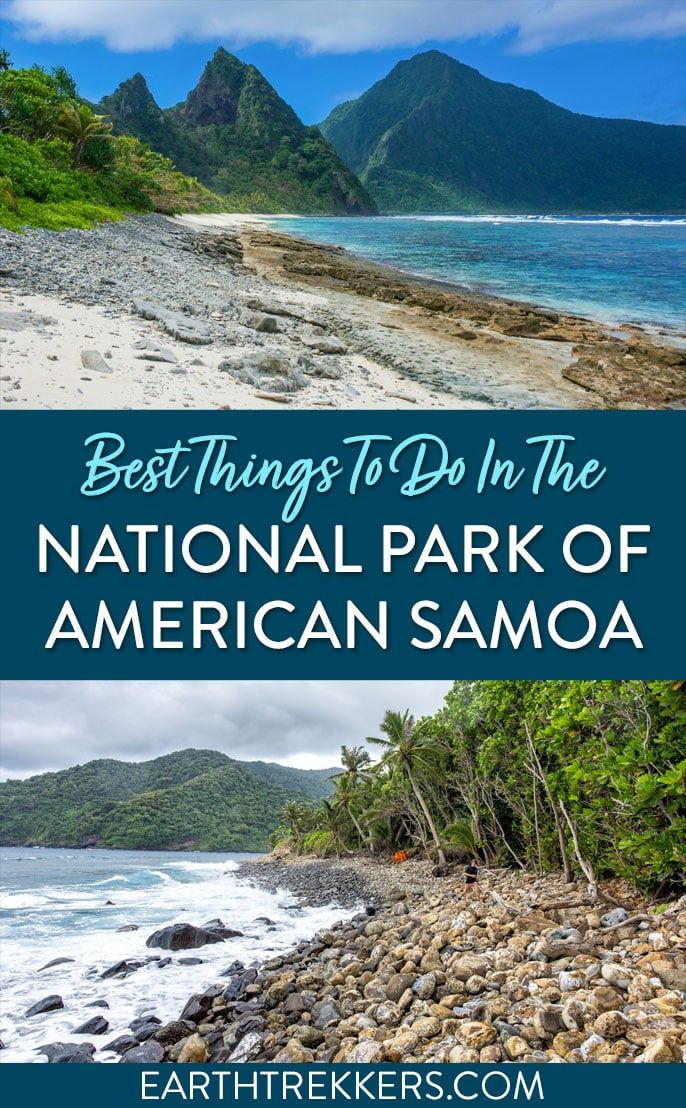

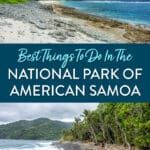





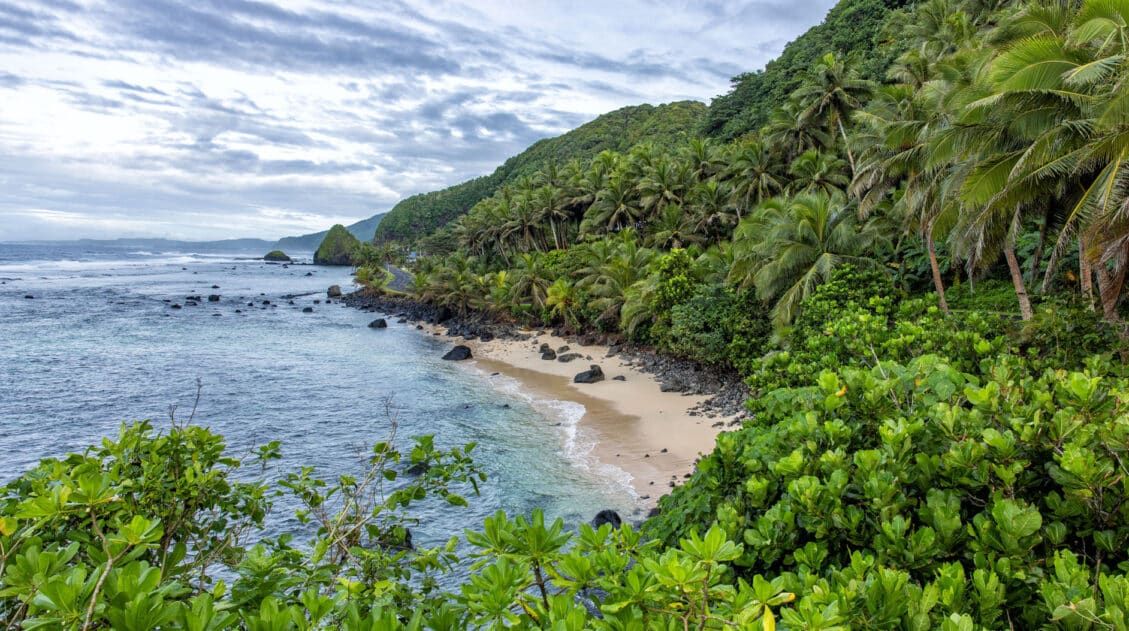

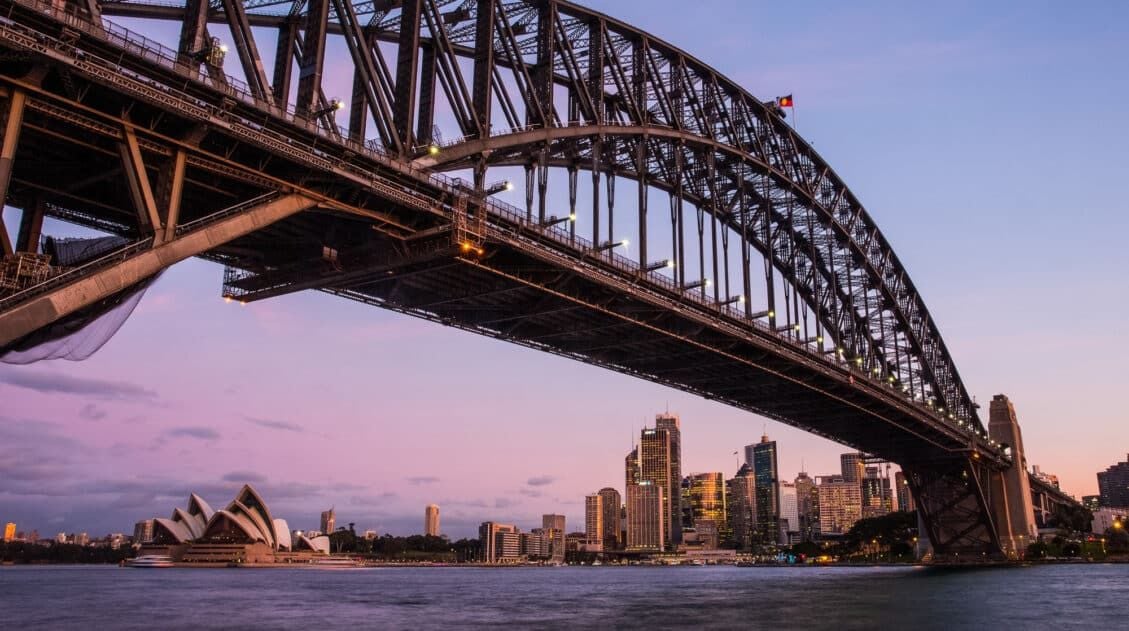







Comments 2